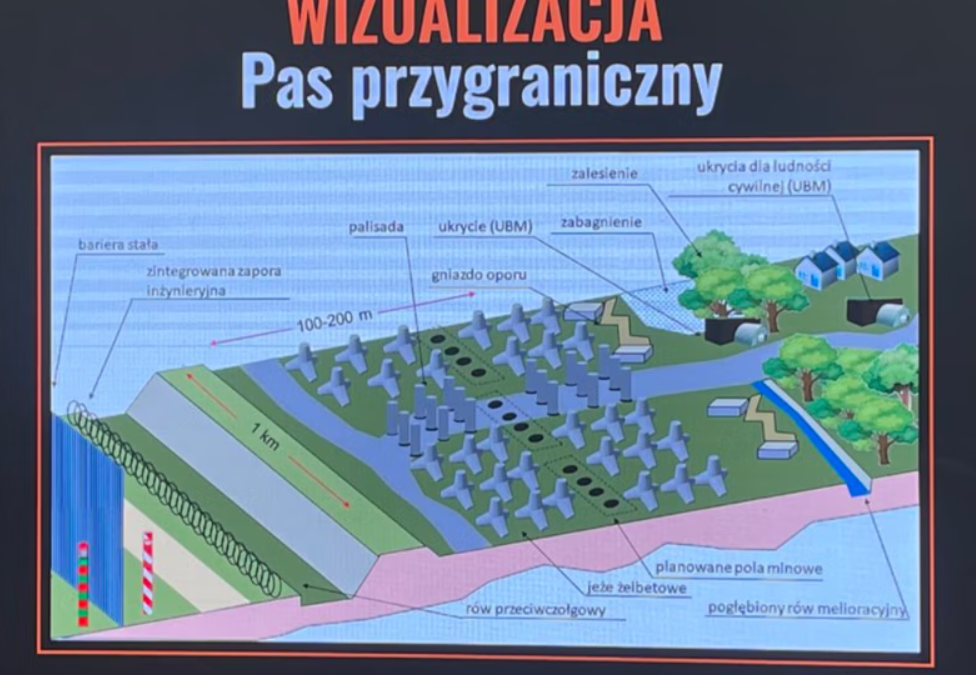Poland has unveiled details of its 10 billion zloty (€2.4 billion) plan to fortify its eastern border in preparation for – but also in the hope of deterring – a potential attack.
The project will include new physical infrastructure, such as bunkers, minefields and anti-tank obstacles, as well as electronic elements including satellite monitoring, thermal imaging cameras and anti-drone systems.
The plans will be coordinated with the three Baltic states – Lithuania, Latvia and Estonia – that also border Belarus and Russia and are stepping up their own military readiness.
"Władze Ministerstwa Obrony Narodowej przedstawiły w poniedziałek założenia Tarczy Wschód, która ma zapewnić bezpieczeństwo polskich granic."#TarczaWschódhttps://t.co/HklcYjoYF5
— Małgorzata Kosińska (@GosiaNieciecka) May 27, 2024
Poland’s project, officially titled “East Shield” but nicknamed the “Tusk Line” by some Polish media, was announced by Prime Minister Donald Tusk earlier this month. However, beyond saying that it would strengthen Poland’s borders with Russia and Belarus, he did not provide details of what the investment would involve.
Today, Władysław Kosiniak-Kamysz, the defence minister, and Wiesław Kukuła, the chief of the general staff of the Polish army, filled in some of those details, including providing visualisations of the new defensive lines.
“The ‘East Shield’ deterrence and defence plan is the largest operation to strengthen the eastern border of Poland, the eastern flank of NATO, since 1945,” said Kosiniak-Kamysz. Poland has since 1999 been a member of NATO, which was itself established in 1949.
Bezpieczeństwo Polski wymaga natychmiastowego wzmocnienia i podejmowania konkretnych i efektywnych działań. Odpowiedzią na zagrożenia jest program #TarczaWschód, na który przeznaczymy 10 mld złotych. To wykorzystanie najnowocześniejszych technologii na rzecz bezpieczeństwa i… pic.twitter.com/Rl2AzGM6FP
— Władysław Kosiniak-Kamysz (@KosiniakKamysz) May 27, 2024
The main goals of the plan are to strengthen capabilities against a surprise attack, to impede the movement of enemy troops, to facilitate the movement of Poland’s own forces, and to protect the civilian population.
However, Kosiniak-Kamysz emphasised that the overriding aim is deterrence: to make attacking Poland unattractive to a potential enemy.
Deputy defence minister Cezary Tomczyk said that they plan for work to begin this year and be completed by 2028. It will involve 10 billion zloty of investment in fortifying 700km of Poland’s borders, as well as in military units and airports, he added.
A bill authorising the spending will be submitted to parliament within the coming weeks. But Kosiniak-Kamysz revealed that the government is also hoping to secure EU funds for the project.
Wiceszef MON @CTomczyk zapowiedział ustawę o inwestycjach mających szczególne znaczenie dla bezpieczeństwa państwa. W ciągu kilku tygodni trafi ona do Sejmu. "Liczę tutaj na współpracę wszystkich sił politycznych". ⤵️ pic.twitter.com/Yc1kkUTWKA
— tvp.info 🇵🇱 (@tvp_info) May 27, 2024
The defence minister noted that the “East Shield” project is separate from – though complementary to – plans by the interior ministry to strengthen and modernise the anti-migrant wall on the Belarus border.
He criticised the existing border wall, built by the former Law and Justice (PiS) government, as “leaky in some places” and in need of improvement.
However, the minister also claimed that the government would seek to avoid politicising the issue of border security and he appealed to all political groups to support the plans.
Donald Tusk has pledged further fortification of the border with Belarus, where Poland is facing a "hybrid war of illegal migration”.
The government's approach has been criticised by Agnieszka Holland, who says it is continuing previous "inhuman" policies https://t.co/DDmf43jEF3
— Notes from Poland 🇵🇱 (@notesfrompoland) May 13, 2024
In his remarks, Kosiniak-Kamysz revealed that Poland could consider renouncing the Ottawa Convention, which aims at eliminating the use of anti-personnel landmines. But he added that “the arming of minefields will only take place when we are sure that war is inevitable”, reports broadcaster TVP.
The defence minister also emphasised that the “East Shield” will be developed in “cooperation with our partners and allies within NATO and the EU, especially with the Baltic countries”.
Last week, Poland and five of its NATO allies around the Baltic – Finland, Norway, Lithuania, Latvia and Estonia – announced plans to jointly develop a “drone wall” to defend their borders with Russia.
The plan by Finland, Norway, Poland and the three Baltic states is meant to prevent Russian 'hybrid attacks', non-military moves that tend to have an element of deniability https://t.co/RzOiB9ptNr pic.twitter.com/RSLFfu5ne3
— Financial Times (@FT) May 27, 2024

Notes from Poland is run by a small editorial team and published by an independent, non-profit foundation that is funded through donations from our readers. We cannot do what we do without your support.
Main image credit: press materials

Daniel Tilles is editor-in-chief of Notes from Poland. He has written on Polish affairs for a wide range of publications, including Foreign Policy, POLITICO Europe, EUobserver and Dziennik Gazeta Prawna.



















